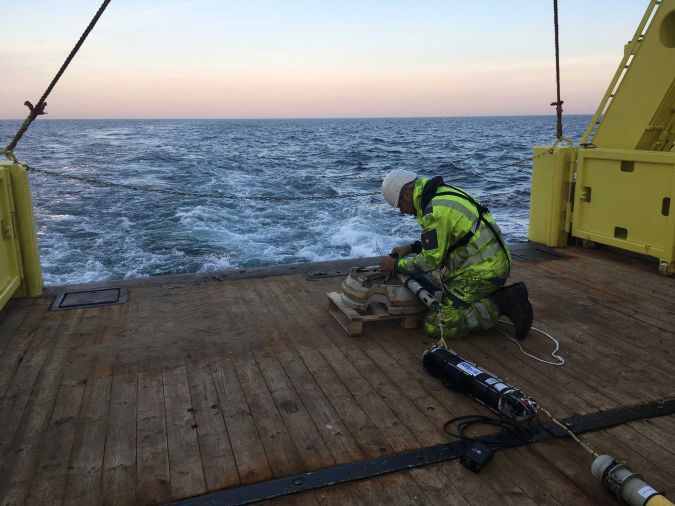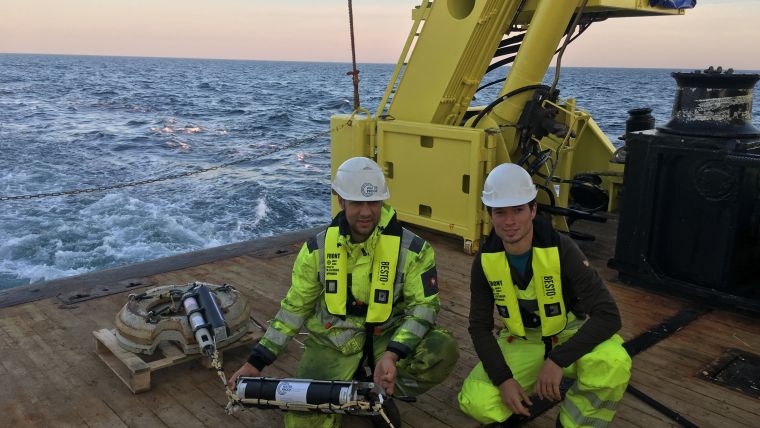Underwater noise monitoring in the North Sea
Jomopans project to monitor continuous sound
Sound is of vital importance for marine animals but, due to the increase in human activities in the sea, sound pollution is a growing concern for marine environmental managers. High levels of anthropogenic noise disturb animals, but the integrated impact of noise on the marine ecosystem is largely unknown. Eleven institutes from the countries bordering the North Sea have joined forces in the Joint Monitoring Programme of Ambient Noise in the North Sea (Jomopans) project to implement a novel monitoring strategy for underwater sound. In this project, measurements at sea are combined with noise maps from numerical modelling to assess the quantitative levels of sound at sea.
Sound and marine life
Sound is omnipresent in the marine environment and it is vitally important for many marine animals. Three key aspects in the survival of animals and species are food supply, reproduction, and protection against threats, and the auditory senses are very important for marine organisms in this context. Usually, underwater visibility is very low, either due to high turbidity – as in the North Sea – or the absence of light in the open ocean. Animals, therefore, use sound to navigate, find food, communicate with potential partners and as a warning against various threats. Many marine mammals use echolocation to detect their prey. Fish species produce a large variety of sounds to communicate, e.g. using their swim bladders. Even some invertebrates can make loud sounds to deter potential enemies and communicate with each other.
Airborne sound
Underwater sound is much less attenuated than airborne sound. Thus marine sound carries over much larger distances than sound in air. In the deep ocean, the low-frequency sound of certain whale species may carry over thousands of kilometres. Much is still unknown about the purpose of these sounds. In a shallow sea, like the North Sea, sound can easily travel dozens of kilometres. This makes sound a very effective communication medium and source of information about the environment for marine animals.
Threats from human activity
The North Sea is one of the world's busiest seas for the transport and maritime industries, and its shared resources represent a crucial economic asset to the North Sea countries. Almost 30,000 ships visit the Rotterdam harbour annually, and Hamburg is, directly and indirectly, responsible for more than 250,000 jobs in Germany. It is estimated that together the removal of old oil and gas platforms and infrastructure, as well as building new renewable energy assets will need a total investment of anywhere between of €390 and €690 billion in the coming decades.
Increased human activities
Over the last decades, the levels of sound have increased due to increased human activities in the sea. Most human activities in the sea produce noise either as a result of the activity (e.g. noise from ships, or from the pile driving of the foundations for offshore wind farms) or of the purpose (e.g. seismic surveying using air guns, or military sonar devices). In illustration, a wind farm will produce high levels of noise for a short period during construction, but it will also cause contribute to a higher total noise level over its entire life cycle due to increased shipping.
These anthropogenic underwater sounds can affect marine animals. Loud impulsive sounds can cause hearing loss (either temporarily or permanently)and displace animals from important habitats, while continuous sounds can mask communication and echolocation of marine animals. In recognition of the vital role of sound to marine life, anthropogenic noise is now regarded as a pollutant and should be considered in environmental quality assessments. Despite the growing interest in marine sound in the last decade, the overall impact of noise on the marine ecosystem is still largely unknown.
The Jomopans project
Quantitative information on the sound levels in the sea is very important for assessing the environmental impact of underwater noise. This information can be combined with the distribution of species in the North Sea to derive a measure of the risk of impact on marine life. To gather this quantitative information, 11 institutes from the countries bordering the North Sea joined forces in the Joint Monitoring Programme for Ambient Noise in the North Sea (Jomopans) project. The project receives 50% of its funding from Interreg North Sea Region.
The aim of the monitoring strategy developed by Jomopans is to gather information for marine managers in relation to the Marine Strategy Framework Directive (MSFD). Monitoring can also be aimed at other purposes, including surveillance of shipping, determining noise characteristics of ships and monitoring the effects of other specific activities, but such monitoring would be different from MSFD monitoring and is therefore not discussed here.

MSFD monitoring is needed to evaluate compliance with the Good Environmental Status (GES) standards required under the MSFD. Maps of a statistical quantity of the sound pressure level will be produced by a combination of measurements and numerical modelling (Merchant et al, 2018). Most fields of marine monitoring are primarily based on measurements, either in-situ measurements or by using remote sensing techniques. Maps are usually obtained by interpolating known measurements. For underwater sound, numerical modelling has been given a major role in the monitoring, which provides a regional overview of the soundscape.
Monitoring based on measurements
Underwater sound shows high variability in both time and space. Monitoring based on measurements would require measurements to be taken at a large number of locations and for long periods in time. This is impractical, if not impossible. Taking measurements is labour-intensive and therefore very costly, and it can be difficult to distinguish between different sound sources. Numerical modelling can in principle overcome these problems. Sound propagation is based on relatively simple physical laws, and numerical models can be used to produce sound maps for large areas with a chosen resolution. Also, the contributions from different sources and source types can be calculated separately. It is important to have good-quality measurements for the validation step of such models.
The Jomopans project is using a strategy combining both measurements and numerical modelling. The workflow shows the process for integrating measurements and modelling in the Jomopans monitoring programme.
Measurements
For the Jomopans project, 14 measurement stations are being deployed around the North Sea. The locations were chosen to obtain measurements of the different sound conditions expected to be found in the North Sea basin. Some are located near shipping routes, while others are located in relatively quiet areas. Most stations cover the shallow North Sea at 10 to 60 metres depth, but one station (in the Norwegian Trench) is located at 300 metres depth. The goal is to gather data for at least one year so that statistically relevant sound levels are obtained for all seasons.
Shipping maps and wind noise maps will be derived from numerical modelling using acoustic models. Various source and propagation models have been tested and the results have been compared, with the objective of providing guidance on the selection of appropriate models and input parameters. Statistical modelling techniques are being applied to quantify uncertainties in the acoustical modelling.
Noise map models
Propagation models need a representation of the environment. Some environmental parameters, like the bathymetry, are known relatively accurately. Other parameters are not known accurately or vary over time, e.g. sea state, water temperature and salinity. The available information about the composition of the sea bottom does not provide direct information on the parameters that are relevant for sound propagation.
Noise map models need input of information about the sound sources. Semi-empirical models are used for ship traffic and wind noise. Information of the ship traffic is derived from the Automatic Identification System (AIS), but that does not cover all ships and does not provide direct information on the acoustic source levels of ships.
As a final step, the monthly percentiles of the sound pressure level resulting from the modelling will be validated against the results from the measurements at the 14 stations.
Harmonization
Jomopans is not an isolated project. Around the world, several other projects focus on underwater sound. Jomopans has learned from previous efforts, like the BIAS project in the Baltic Sea, and has close links to other projects (e.g. QuietMed in the Mediterranean, COMPASS in Scotland and Ireland, and the ECHO project in Canada). Jomopans will pass its information and experience on to future projects, such as JONAS which is about to start in the Atlantic region. Special attention will be paid to standardization of terminology, measurements and propagation modelling, as standards are very important to the further advancement of this new field.
As mentioned above, Jomopans covers only part of the total subject of the environmental effects of anthropogenic underwater sound. There is still much work to be done, especially relating to the effect of sound on animals, e.g. injuries or behavioural response. It is hoped that the Jomopans project will provide a solid basis for monitoring underwater sound, on which marine managers and scientists can build.
Conclusions
The Jomopans project is developing a monitoring programme for continuous sound in the North Sea. It combines numerical propagation modelling and field measurements to obtain high-quality maps of the sound level in the North Sea. These maps will be used to assess the Good Environmental Status in relation to underwater sound.
Sound or noise?
The term ‘sound’ is used to refer to the acoustic energy radiated from a vibrating object, with no particular reference to its function or potential effect. ‘Sounds’ include both meaningful signals and ‘noise’ which may have either no particular impact or may have a range of adverse effects. The term ‘noise’ is only used when adverse effects are specifically described, or when referring to specific technical distinctions such as ‘masking noise’ and ‘ambient noise’.
Environmental monitoring
Environmental monitoring describes the processes and activities that need to take place in order to characterize and monitor the quality of the environment. Environmental monitoring is used in the preparation of environmental impact assessments, as well as in many circumstances in which human activities carry a risk of harmful effects on the natural environment. All monitoring strategies and programmes have reasons and justifications, which are often designed to establish the current status of an environment or to establish trends in environmental parameters. In all cases, the results of monitoring will be reviewed, analysed statistically and published. The design of a monitoring programme must therefore have regard to the final use of the data before monitoring starts. (Source: Wikipedia)
Acknowledgements
Jomopans is an Interreg project supported by the North Sea Programme of the European Regional Development Fund of the European Union and several national funding bodies.
Further reading
Merchant, N. D., Farcas, A., Powell, C. F. (2018) Acoustic metric specification. Report of the EU INTERREG Joint Monitoring Programme for Ambient Noise North Sea (JOMOPANS). www.northsearegion.eu/jomopans.
Credits: WaterProof Marine Consultancy & Services. This article was published in print in the May/June 2019 issue of Hydro International.

Value staying current with hydrography?
Stay on the map with our expertly curated newsletters.
We provide educational insights, industry updates, and inspiring stories from the world of hydrography to help you learn, grow, and navigate your field with confidence. Don't miss out - subscribe today and ensure you're always informed, educated, and inspired by the latest in hydrographic technology and research.
Choose your newsletter(s)
























